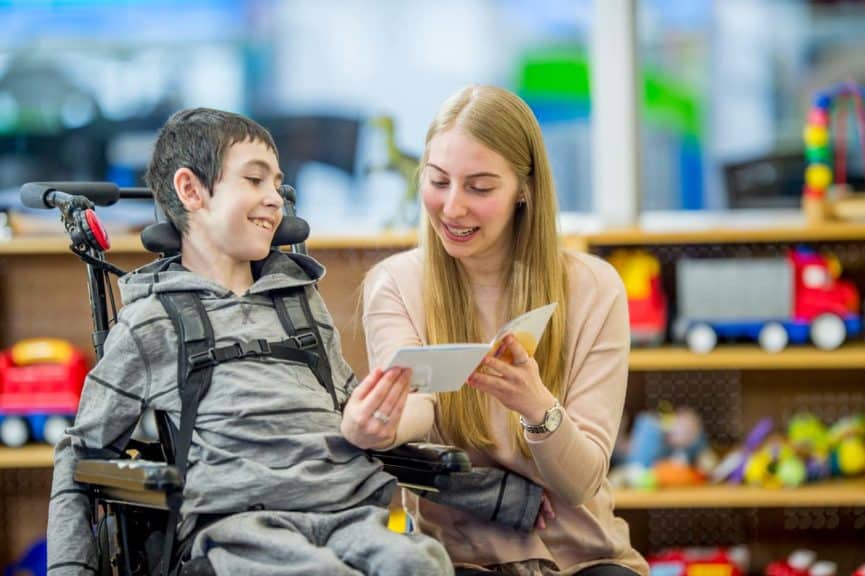As the Church, we are called to teach the Gospel of Jesus. Period. I hope it’s obvious to all of us that this includes the disabled. To begin with, even a casual reading of the gospels makes it clear that Jesus spent a significant amount of his time with and ministering to the disabled:
- Zacchaeus was of unusually short stature
- The paralytic at Capernaum
- Those afflicted with leprosy
- The woman with the issue of blood
- The man with the shriveled hand
- The man born blind.
This list doesn’t even include the interactions of the Trinity and the disabled in the Old Testament or their interactions with the disabled in the early church. Time and again we see the Trinity, and Jesus in particular, elevating the disabled to be fully included in society.
And, in some cases, like the life story of Moses, we see a man with a speech impediment who ultimately a significant impact on the course of human history.
Consequently, part of our calling as kidmin leaders is to find the most effective ways to teach all of our kids. That can feel pretty intimidating—and downright scary—at times.
But in can be encouraging to see how far we’ve come already.
Reflect on the History of Inclusion
A groundbreaking federal statute called IDEA (Individuals with Disabilities Education Act) passed in 1975. IDEA ensures the right of every child in special education to be in the least restrictive environment.

Before IDEA passed, children with disabilities rarely had contact with their non-disabled peers. Some kids were not educated at all, and others were isolated in special schools. Even special education classrooms in the mainstream school were rare.
Bringing disabled students into the same schools and classrooms as their peers opened up a new world of opportunities for these children. The ripple effects of that ruling continue to this day in work, leisure, and housing opportunities for the disabled.
The early church showed the world the importance of the least among us, the disabled, the weak, and their vital role in society.
My Story of Inclusion
As mom to two boys with autism, I am truly thankful to those who have advocated for those with disabilities. Some of the advocating that happened before I was even born and is not only impacting my life, the lives of my own children, and the lives of the children I minister to, but it extends even further into generations to come.
The early church showed the world the importance of the least among us, the disabled, the weak, and their vital role in society. The church is uniquely qualified to do this. Because of this, the church of today has an opportunity and responsibility to reclaim its leadership in this area. As is often the case, children’s ministry can lead in this area.

So, knowing that teaching the message of Jesus to the disabled is a central part of our calling, and recognizing that the best practice for teaching people with disabilities is full inclusion with typical peers in the least restrictive environment we can provide, how do we make this happen in our ministries?
Before You Do Anything Else, Pray
Figuring out how to implement inclusion can be hard. Really hard. Prayer is always the first step.
God has a plan for the disabled and knows your limitations and struggles and fears. He has also shown Himself to be the most creative communicator of His message. Tap into His creativity before you start problem solving.
Consider Your Goals
Next, spend some time thinking and praying about your ultimate goal for integration. If we are truly committed to providing the least restrictive environment, our goal is 100% inclusion.
However, this doesn’t mean we need to have every single disabled child thrown into a typical large group/small group or classroom setting without support. No one benefits from that approach!
Instead, we need to evaluate the readiness of each child to be fully integrated. This will vary from child to child —in fact, the readiness of some of your students will vary from week to week.
We need to evaluate the readiness of each child to be fully integrated.
Consider this sample list of stages of inclusion and consider which best describes each of your special needs kids today:
- Needing 1-1 supports in a breakout room
- Needing 1-1 supports in a breakout room with minimal (3-5 minutes or less) inclusion in the main classroom
- Needing 1-1 support in a breakout room with 10+ minutes inclusion in main classroom
- Needing 1-1 supports in inclusion classroom with 10+ minutes in break room
- Needing 1-1 supports in inclusion classroom with 3-5 minutes or less in breakout room
- Needing 1-1 supports fully in inclusion classroom
- Needing 1-5 supports in inclusion classroom for redirection
- Fully integrated with peers, making use of fidgets when needed
- Fully integrated with no supports

Build up to Full Inclusion
As you can see, the “least restrictive environment” can look quite different for each child. Finding the right level for each student is a great start, but if our goal is full integration, it cannot be our end.
It is important to remember what the goal is and to have realistic expectations along the way.

Did you know? David C Cook offers HeartShaper Children’s Curriculum, which includes special needs friendly activities that work well with all kids—each activity approved by special needs experts. Plus, HeartShaper offers free resources you can use in your ministry to kids with special needs. Check them out here!
Abby’s Story
Let’s use Abby as an example. Abby has Down Syndrome and is in the 3rd grade. She gets overwhelmed in large groups but loves being around people.
Abby starts off in the breakout room with a 1-1 buddy. That buddy and Abby are learning the same lessons that the typical peers are, but with modifications to help her better understand the lesson.
While Abby works with her buddy, the songs that are usually part of kids’ worship in the main classroom are playing in the background. These two steps are helping Abby get ready for the larger group.
After a few weeks, Abby and her buddy come over to the larger classroom to participate in the music portion of the class. Abby loves it, but the music is too loud for her.
The buddy provides Abby with a pair of noise cancelling headphones which help her a lot. After music is over, Abby and her buddy go back to the breakout room to finish the lesson.
During the next three months, Abby and her buddy work on being able to spend more and more time in the main class. Some days Abbys is able to spend 30 minutes with the large group—other days 10 minutes is pushing it. But that’s ok because we’re giving Abby time to get used to the environment while giving her opportunities to make friends and establish community.
After a year Abby is in the main classroom for the whole time and only needs a buddy to help her with her adapted lesson. For Abby, this is inclusion in the least restrictive environment.
Recognize Each Child’s Uniqueness
Of course, each child has distinct needs and abilities. You may have some children who are able to immediately go into full inclusion without support and others who may only be able to handle breakout rooms.
Even with the children who are farthest from full inclusion, you can provide peer modeling by bringing a rotation of typical peers into the breakout room. This interaction benefits both the child with a disability and his peers.
Creative Ways to Address Special Needs
You may be saying, “This sounds amazing, but we don’t have the space for a breakout room!” Don’t panic, there are creative ways to design space for a child who can’t handle the main classroom.
There are creative ways to design space for a child who can’t handle the main classroom.
Mobile Classrooms
You could provide them with a “mobile classroom”. This could be as simple as a backpack containing an activity, a Bible lesson, a verse for the day, and some fun reinforcements that the child enjoys.
A mobile classroom allows the buddy to interact with the child. It also empowers him to engage with the lesson even if he is in a hallway, on a swing, or in a sandbox.
You would pursue the same pathway to inclusion as described before, just without a designated breakout room.

Keep in mind that you should always follow your church’s safe child protocols. (This article teaches you the best ways to keep your kids safe). A best practice is to never have an adult alone with a child in a non-public space.
Preparing for Transitions
Something else to be mindful of is age/grade transitions, including:
- Preschool to Kindergarten
- 5th grade to Jr High
- Jr High to Sr High
- Sr High to Adult
A child who is fully integrated in preschool may need more supports—at least initially—in her Kindergarten class. The same may be true for a child transitioning to Jr High.
In our church, we have students sit with their parents during worship services and then participate in a separate group during the week. In our situation, we first help the student learn to sit in church.
Using the stages of inclusion listed above, we work to increase kids’ ability to sit in church until they are able to independently sit with their parents for the entire service.
The stages of inclusion also translate to teen programs and adult options. With the goal of full inclusion in mind, think about the least restrictive option your church offers, and then work toward that for each student.
The Ultimate Goal
The last step toward a least restrictive environment is the most important. This is because the goal isn’t for people to feel pity for those with disabilities, or to be willing to help the disabled, or even to see the disabled person as a friend and equal.
The goal is for people with disabilities to have the opportunity to be co-laborers in the gospel.
Spend some time thinking through these questions and the implications of your answers:
- Do your special needs students go on mission trips?
- Are your disabled adults serving during worship services?
- Do your children help with classroom jobs?
- Are disabled individuals serving on your boards and committees?
Jesus calls everyone to join in the work of sharing the gospel. He gave no disclaimers and made no exceptions.
My prayer is that as we continue to strive for the least restrictive environment for our disabled co-laborers, we will give the world a vivid image of the Kingdom of Heaven.










